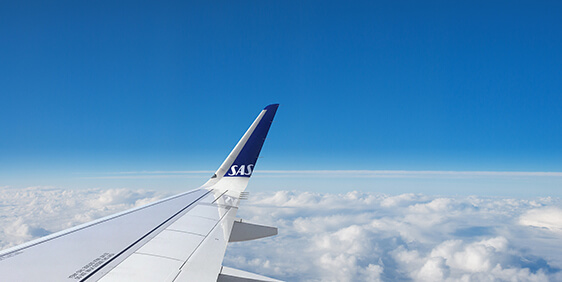
SUSTAINABLE AVIATION FUEL
To realize the airline industry’s environmental objectives, the future of aviation is largely dependent on the development of alternative and sustainable jet fuels based on one or more renewable sources.
Unlike most types of transportation, aviation has no real alternative to the liquid fuels that are currently used. There is also a need to secure access to liquid fuels as the supply of fossil alternatives is expected to decline and/or become more expensive.
Developing alternatives that can reduce climate-impacting emissions while also fulfilling the established sustainability criteria is of the utmost importance.
The principal sustainability criteria are that production shall be sustainable in the long-term and thus not compete with the production of foodstuffs or access to potable water, do not harm biodiversity and use as small an area of land as possible. According to the IATA, phasing in alternative fuels over time could enable a reduction in the air travel industry’s emissions by up to 80% throughout its lifecycle.
As of today, it is possible to use alternative jet fuels that are based on such renewable sources such as camelina, jathropha, algae, animal oils, fats and various types of coal-based sources such as waste from industry, households, agriculture, forestry, paper mills and so forth. These two specifications allow up to a 50% blend with the traditional fossil fuels to ensure the high requirements related to engines, as well as fuel supply systems on aircraft and on the ground.
Initiatives are under way in a number of countries worldwide to evaluate the possibility of producing alternative sustainable jet fuels based on renewable sources. These initiatives often take the shape of partnership projects between private and public players. Unfortunately, we have not yet experienced the same commitment in Scandinavia.
As a result of the approved certifications, the technological prerequisites are in place and buyers are available, including SAS. It is now a matter of initiating large-scale production at competitive prices.
There are currently a limited number of suppliers that can deliver minor quantities of a certified alternative jet fuel at a high price. These suppliers have provided a number of airlines with sufficient fuel to perform flight trial demonstrations. However, SAS has opted not to purchase these fuels because of very high prices. Furthermore, SAS’ sustainability requirements must be fulfilled.
SAS commitment
For the past decade, SAS has worked on various activities aimed at accelerating the development of alternative and sustainable jet fuels.
SAS is also involved in a number of national and international forums, such as the IATA/ATAG biofuel network, the Sustainable Biofuel Network in Copenhagen, Cleantech Cluster, Global Green Growth Fora (3GF), and various Scandinavian interest organizations working in the area.
SAS continued to be a driving force in the work in NISA, which brings together aviation players in the Nordic region in the effort to accelerate commercialization of alternative jet fuel production in the region.
SAS and Avinor has been working on different activities in order to accelerate commercialization and production of alternative sustainable jet fuel in Norway.
SAS continues to talks with various potential stakeholders, regarding the possibility to produce alternative sustainable jet fuels in Scandinavia. SAS also continues to clearly indicate to existing and potential future producers of jet fuels that it is prepared to purchase alternative jet fuels if the sustainability criteria are in place and the price is competitive.
PRODUCTION OF SYNTHETIC SUSTAINABLE AVIATION FUEL
Vattenfall, SAS, Shell and LanzaTech in partnership
HySkies is an important project toward fossil free aviation where Vattenfall, SAS, Shell and LanzaTech together are investigating the production of synthetic sustainable aviation fuel (SAF) using the LanzaJet[TM] “Alcohol to Jet” technology on a large scale in Sweden.
Instead of using virgin fossil material in the production process, the synthetic SAF will be produced from fossil free electricity and recycled carbon dioxide from district heating.
The synthetic SAF, also known as electrofuel, will be produced from fossil free electricity and recovered carbon dioxide using the LanzaJet “Alcohol to Jet” technology, developed by LanzaTech and the U.S Department of Energy’s Pacific Northwest National Laboratory (PNNL).
When full production is up and running it could provide SAS with up to 25 percent of its global demand for sustainable aviation fuel in the 2030s.
Green fuels for Denmark
In Denmark, SAS is a partner in the project Green Fuels for Denmark, headed by Ørsted. The project aims to produce electrofuel for aviation using wind power.
The production facility is expected to produce its first batch of synthetic SAF in 2025 and up to 250,000 tonnes by 2030 which would correspond to the consumption of SAS Copenhagen flights.